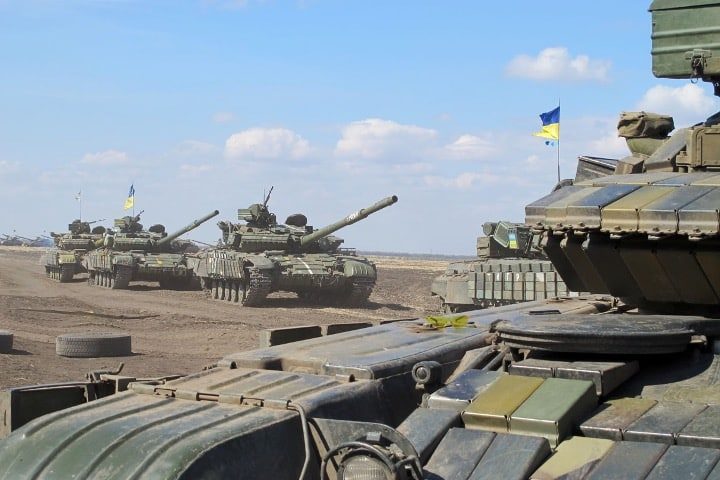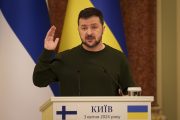
SINGAPORE — On May 3, the Pentagon revealed a $300 million arms package for Ukraine, right before an anticipated spring offensive by Ukrainian troops. The package is America’s 37th tranche of military help to Ukraine since August 2021, bringing the total amount of military aid to Kyiv since February 2022 to an astounding $35.7 billion.
Based on a statement from the Pentagon, the package encompasses ammunition for Ukraine’s American-provided HIMARS rocket artillery systems, 155mm howitzers and artillery rounds, mortar rounds, wire-guided missiles, shoulder-fired anti-tank missiles, and Hydra-70 rockets.
As of January, America stopped divulging how much of each ammunition type its arms packages included, but rather has been pointing out the total number of each piece of equipment supplied to date on supplemental fact sheets together with each statement from the Pentagon.
On March 20, Ukraine obtained over half a million 155mm shells, bringing the total number given since last February to 1.5 million. The recent package on May 3 marks the third batch of arms declared since that date, with every fact sheet indicating that Ukraine has procured “over 1,500,000” 155mm artillery rounds.
However, Oleksii Reznikov, Ukraine’s defense minister, insisted that the current arms delivery pace is falling far behind the monthly figure of 356,400 rounds that Ukraine allegedly needs to fire its Western-provided guns at full capacity.
For several months, Kyiv has been preparing for an offensive against Russian forces, with Ukrainian leader Volodymyr Zelensky declaring that the operation would start “soon.”
Having said that, a report by Politico recently asserted that the U.S. government under President Joe Biden has been privately concerned that Ukraine’s operation might fail. The Ukrainian military has been supposedly beleaguered by a lack of ammunition, with observers contending that the May 3 package would not do much to mitigate the paucity.
On May 2, top Zelensky advisor Mykhailo Podolyak acknowledged in an interview with Italian daily Corriere della Sera that his country has had to tweak some long-inactive Western weapons from its supporters.
Podolyak made those admissions when he was questioned on a recent Financial Times (FT)report alleging that all 20 self-propelled howitzers Rome had deployed to Kyiv were defective and not combat-ready. He tried to gloss over the situation, saying that as “the self-propelled guns had been in warehouses for a long time, they require an obvious operational upgrade.” He also elaborated that “it often happens that this or that [Western] weapon is developed here in Ukraine,” stating that Kyiv requires all the weapons deliveries it could obtain as soon as possible.
“Understandably, the ideal would be to receive ready-to-use weapons but, let’s be realistic, we are always ready to repair and refurbish them,” the Ukrainian official noted, without providing additional details on the allegedly defective Italian howitzers, justifying that it would be unwise to reveal information that Russia could take advantage of.
Last month, Italian media reported that Rome had deployed a series of old U.S.-designed M109 SPGs (self-propelled howitzers) that had been stored in depots and refurbished with American funding to Kyiv.
Following the FT’s exposé on the howitzers, an Italian defense source told media outlet il Fatto Quotidiano that the guns were “outdated vehicles, which were not in use in Italy,” highlighting that the obsolete guns thus had to be sent to a U.S. company for overhauls. The source then hinted that “the problem may have been in the maintenance phase,” instead of blaming the Italian government for the reportedly malfunctioning arms.
Last week, The New York Times reported as well that German-made Panzerhaubitze (PzH) 2000 howitzers mobilized to Kiev had experienced considerable challenges on the battlefield due to “viscous central Ukrainian mud.”
The Times stated that the 155mm self-propelled guns were “barely moving forward” owing to the mud, while citing a lieutenant with Ukraine’s 43rd Separate Artillery Brigade as saying: “Until the weather improves, there will be no counteroffensive. The vehicles will get stuck and then what will we do if the shooting starts?”
For the moment, the unit that obtained various PzH 2000s from Germany and the Netherlands over last winter has decided to withdraw all of the howitzers from battle. The unit commander expressed worries that the 60-ton machines would be unable to flee in the face of Russian fire, the same Times report stated.
In Russia, on May 7, Russia’s Federal Security Service (FSB) announced that they had arrested Ukrainian agents who were attempting a drone attack on a military airfield in central Russia, and that the agents used a small Aeroprakt A-32 plane to transport explosives from northern Ukraine to Russia’s Tula Region.
The agents supposedly tried to target A-50 early-warning and reconnaissance aircraft located near the city of Ivanovo, some 250 kilometers (155 miles) to the northeast of Moscow.
The Ukraine-linked pilot and other accomplices in the operation were arrested upon landing, the FSB disclosed, amid a series of train derailments and drone attacks on oil terminals on Russian soil. Last week also saw two unmanned aerial vehicles trying to target the Kremlin in what Russian officials claimed was an assassination attempt on Russian President Vladimir Putin staged by Kyiv. Kyiv has dismissed claims of involvement in the incident.
Previously, the FSB also revealed that it had detained two Ukrainian nationals who were trying to kill an unnamed high-ranking official working at the Zaporizhzhia Nuclear Power Plant.
Ukrainian intelligence chief General Kirill Budanov told Yahoo News in an interview held last month but published last week that his organization, the GUR, would persist in its efforts targeting Russians “anywhere on the face of this world.”
Budanov, who leads the Main Directorate of Intelligence of the Ukrainian Ministry of Defense, has been associated with various sabotage and assassination operations involving Russian officials, with a foiled plot to kill top Russian officials in Crimea being the most recent incident.
When asked if the GUR was complicit in the murder of Russian journalist and political activist Darya Dugina in Moscow last year, Budanov chillingly replied, “Don’t continue with that topic. All I will comment on is that we’ve been killing Russians and we will keep killing Russians anywhere on the face of this world until the complete victory of Ukraine.”
The Kremlin has pledged that such provocations would “not be left unanswered.”



